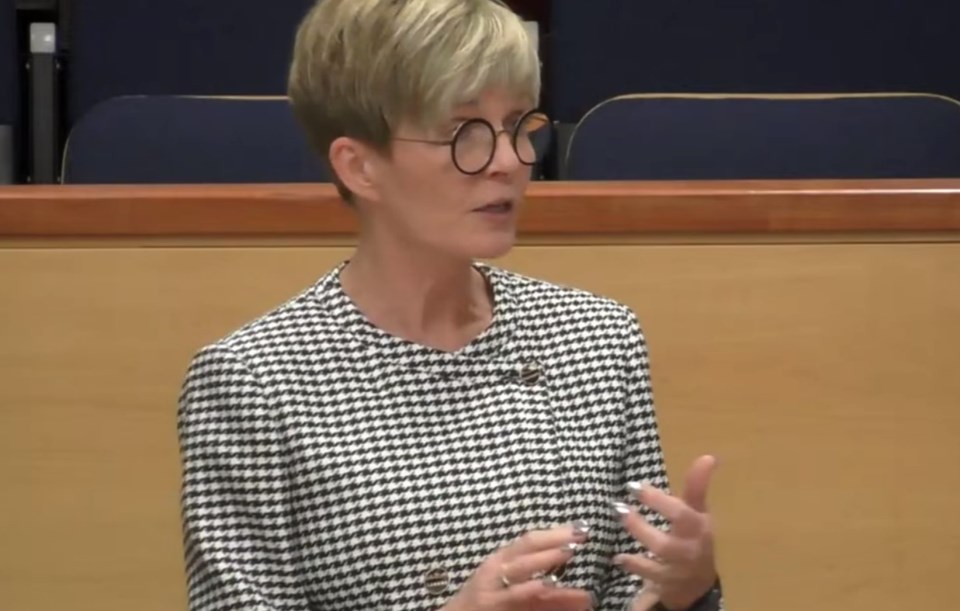The pressures in today’s hospital system are worse than what Lynn Guerriero has ever seen in her 36 years in the sector, says the Niagara Health president and chief executive officer.
During a presentation to regional councillors and staff during a recent committee-of-the-whole meeting, she and other top brass from the health system outlined what the next few years will look like as it transitions to the three-hospital model.
Some of the unfortunate realities being faced were also part of the presentation, such as Niagara being short more than 80 family doctors, which translates to about 140,000 residents who don’t have one. There are also significant pressures with staffing and patient volumes at every site, causing massive wait times and patients being admitted to a hospital on stretchers for hours at a time when there is no room available. “While no area of our hospital is untouched by this, these shortages are most apparent in our emergency department and our operating room,” she said.
A new south Niagara hospital in Niagara Falls is expected to be completed by 2028, which means the closure of urgent care centres in Fort Erie and Port Colborne, as well as the current Niagara Fall site on Portage Road. These sites are “beyond the point of renovation,” and are “not suited to providing quality patient care into the future,” said Guerriero.
The Welland Hospital site is planned to remain a 24-7 emergency department following a capital grant through the province that Niagara Health is hopeful will come through, she said. Programs and services at the Fort Erie and Port Colborne sites will move to the new hospital in Niagara Falls, and also transition to primary care.
In Niagara Falls, the soon-to-close hospital will be gifted to the city, which generated some questions from councillors last week.
St. Catharines Mayor Mat Siscoe asked if the City of St. Catharines was given the same offer when its former hospital closed more than 10 years ago. Guerriero and chief financial officer Angela Zangari, both of whom were not in the roles they have today when that transition occurred, said they would report back to Siscoe with more details about what transpired.
Guerriero also noted that the City of Niagara Falls is contributing $43 million to the new hospital.
Later in the meeting, Niagara-on-the-Lake Lord Mayor Gary Zalepa was also curious about a similar transaction in his town. In 2017, the town bought the closed hospital for $3.5 million.
“I’m somewhat perplexed to know my community had to buy the hospital in our town for full market value,” he said, also asking that Niagara Health report back to him with details on that transaction years ago, before he was elected.
He said NOTL residents, especially those who are aging, are “anxious” about travel times to emergency departments and that Niagara Health and the province should “explore other levels of care closer to the community.”
When the new south Niagara hospital is completed, it will bring an additional 156 beds to the region, adding up to a total of 469 beds.
Guerriero said there are about 100 beds currently occupied by people who don’t need to be in a hospital, but are unable to be placed in long-term care or treated at home.
While the region and local municipalities are working to recruit physicians and medical experts from the U.S, Europe, and Australia, Guerriero said she believes the new Niagara Falls hospital will be a major draw.
“They want modern equipment. That’s what they’ve been trained on,” she said, referring to those who are graduating from medical school.
Pelham Regional Coun. Diana Huson asked Guerriero about a recent presentation to regional council from a group of international medical experts who said they are willing to help address the shortage in Niagara, but have faced too many hurdles getting certified to practise in Canada. Guerriero said she was unaware of the group, but noted local programs in place designed to train international nurses.
The head administrator for the hospital system said she understands closures of sites in Fort Erie and Port Colborne in July are causing “anxiety in those communities,” but later said primary care is the future and that these decisions are “the best way we can use our limited resources.”
Fort Erie Regional Coun. Tom Insinna pointed to upcoming engagement sessions Niagara Health is organizing in the coming weeks to talk about their plans. He noted weather in Fort Erie and along Queen Elizabeth Way near his town’s border with Niagara Falls at Sodom Road as places that always seem to get hit much harder than other areas of the region. “That’s the biggest push and I hope you’re prepared for that,” he said about the expected tone of the Fort Erie engagement session .
The provincial government is funding 90 per cent of construction of the new hospital, which equates to Niagara Health coming up with about $230 million to cover the remaining 10 per cent of construction costs, as well as furniture and equipment inside the site.
The community engagement sessions kicked off with a virtual webinar Tuesday, March 12, which was recorded and is available for viewing.
Niagara-on-the-Lake's session is April 15 at the community centre at 6:30 p.m.



